Characteristics and Mechanisms of the Impact of Heterogeneity in the Vadose Zone of Arid Regions on Natural Vegetation Ecology: A Case Study of the Shiyang River Basin
Abstract
1. Introduction
- (1)
- Enhanced recognition of the vadose zone’s ecological regulatory functions;
- (2)
- Systematic investigations into how lithostructure-dependent drainage hysteresis mechanisms constrain vegetation ecology.
2. Materials and Methods
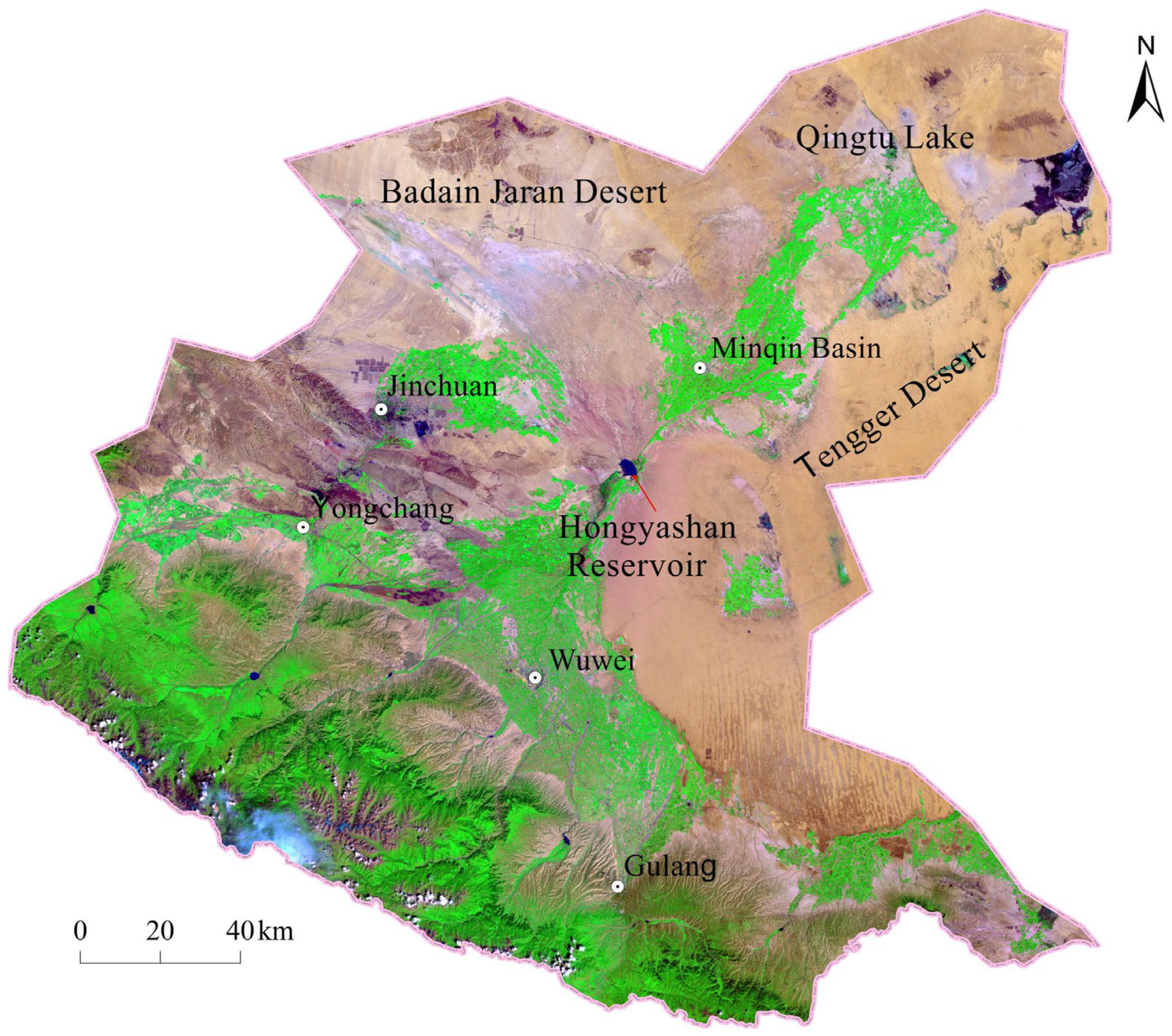
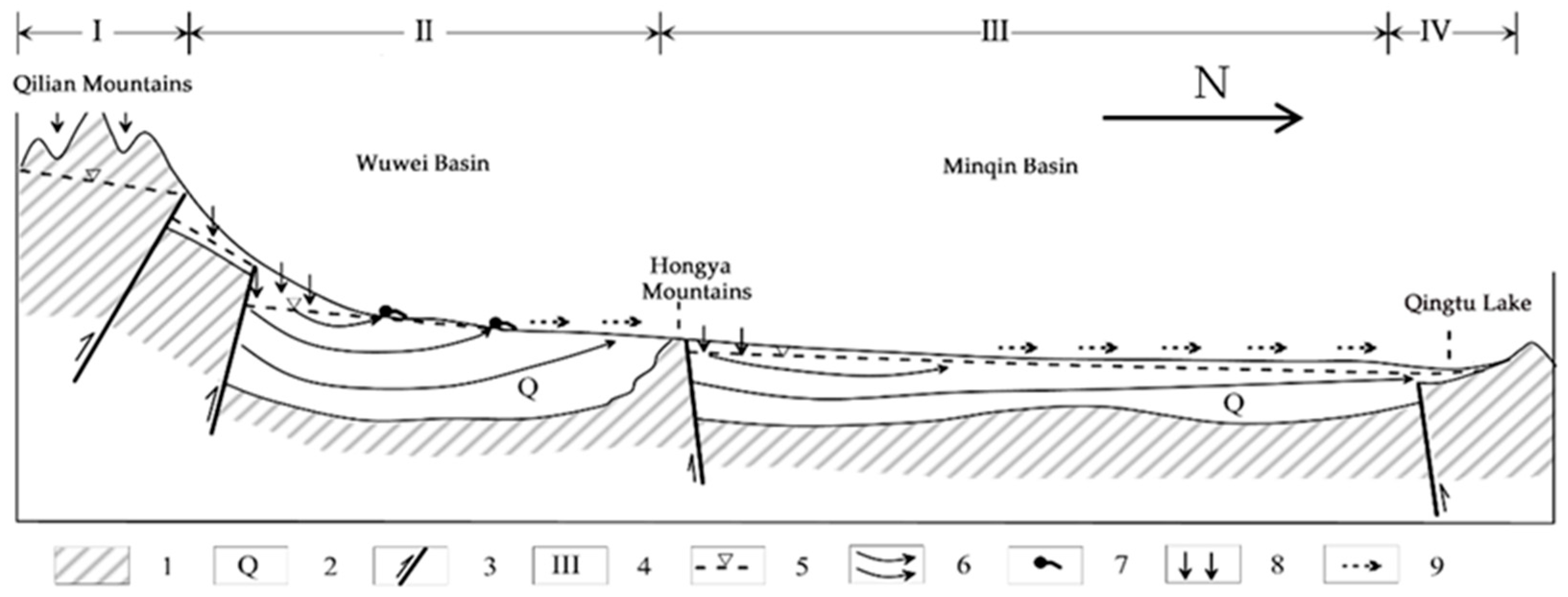
2.1. Data Compilation and Comprehensive Analysis
2.2. Field Investigations
2.2.1. Preliminary Fieldwork
2.2.2. Supplementary Ecological Quadrat Surveys
2.2.3. Soil Column Experiments and Numerical Modeling
3. Results
3.1. Characterization of Vadose Zone Heterogeneity Impacts on Natural Vegetation Ecology
3.2. Mechanisms of Vadose Zone Heterogeneity Impacts on Natural Vegetation Ecology
3.2.1. Ecological Response Mechanisms of Natural Vegetation to Homogeneous Lithological Structures
3.2.2. Ecological Response Mechanisms of Natural Vegetation to Stratified Lithological Structures
4. Discussion
5. Conclusions
- (1)
- The vadose zone has a significant impact on the ability to supply water to the root zone of natural vegetation and the depth of root development, resulting in different growth statuses of natural vegetation under different lithological structures of the vadose zone. When the groundwater depth is similar, if the vadose zone has a fine texture, it has a strong water-holding capacity, a greater capillary rise height, and higher soil moisture content, making it easier for surface vegetation to obtain water and grow relatively well.
- (2)
- The root development depth of vegetation in the same community may vary under different lithological structures of the vadose zone. Moreover, within the same root development depth range, vegetation communities may experience different soil moisture deficit conditions at different times due to differences in the lithological structure of the vadose zone, resulting in different water requirements for vegetation under drought stress and different sources of water utilization for natural vegetation.
- (3)
- When groundwater levels gradually recover and rise, under the same vegetation conditions, different lithological structures of the vadose zone support different capillary water rise heights and speeds, thereby having different impacts on groundwater ecological functions. The finer the lithological particles, the greater the capillary water rise height and speed, and the faster and more abundant the soil obtains groundwater recharge, which is more beneficial to the growth of surface vegetation. The supported capillary rise height of different lithological structure combinations is more complex and varies with lithological thickness, position, and number of layers.
- (4)
- When groundwater levels continue to decline, the vadose zone in arid regions has the ecological effect of maintaining the survival of surface vegetation. Its effective water-holding capacity can sustain the survival of typical vegetation in arid regions (such as Haloxylon ammodendron) for a growing season, thereby expanding the meaning of the “ecological water level”. Lithologic particle refinement in the vadose zone increases soil water-holding capacity but raises the wilting point, limiting overall water retention, while medium-grained lithologies optimize water regulation by balancing retention and wilting thresholds. This balance sustains vegetation function under drought, offering significant ecological advantages. Compared with homogeneous lithologies, combined structures of multiple lithologies are more conducive to holding greater effective water-holding capacities and have stronger ecological effects. The effective water-holding capacity is greater in a fine-over-coarse structure than in a coarse-over-fine structure, and greater in a coarse-grained interlayer than in a fine-grained interlayer, resulting in stronger ecological effects.
Author Contributions
Funding
Institutional Review Board Statement
Informed Consent Statement
Data Availability Statement
Conflicts of Interest
References
- Sun, Z.; Wang, J.; Ge, M.; Qiao, S. Identification of groundwater-dependent terrestrial vegetation based on water stable isotopes: Research progress, challenges, and future research prospects. Bull. Geol. Sci. Technol. 2020, 39, 11–20. [Google Scholar]
- Maihemuti, B.; Simayi, Z.; Alifujiang, Y.; Aishan, T.; Abliz, A.; Aierken, G. Development and evaluation of the soil water balance model in an inland arid delta oasis: Implications for sustainable groundwater resource management. Glob. Ecol. Conserv. 2021, 25, e01408. [Google Scholar] [CrossRef]
- Li, L.; Wang, Z.; He, H.; Ma, Z.; Xie, X.; Wei, C. Research on multi-dimensional equilibrium allocation of water resources in inland arid regions based on eco-hydrological threshold regulation. J. Hydraul. Eng. 2019, 50, 377–387. [Google Scholar]
- Huang, F.; Chunyu, X.; Zhang, D.; Chen, X.; Ochoa, C.G. A framework to assess the impact of ecological water conveyance on groundwater-dependent terrestrial ecosystems in arid inland river basins. Sci. Total Environ. 2020, 709, 136155. [Google Scholar] [CrossRef] [PubMed]
- Chunyu, X.; Huang, F.; Xia, Z.; Zhang, D.; Chen, X.; Xie, Y. Assessing the ecological effects of water transport to a lake in arid regions: A case study of Qingtu Lake in Shiyang River Basin, Northwest China. Int. J. Environ. Res. Public Health 2019, 16, 145. [Google Scholar] [CrossRef] [PubMed]
- Cui, H.; Zhang, G.; Wang, J.; Wang, Q.; Lang, X. Influence of multi-layered structure of vadose zone on ecological effect of groundwater in arid area: A case study of Shiyang River Basin, Northwest China. Water 2022, 14, 59. [Google Scholar] [CrossRef]
- Huang, F.; Zhang, D.; Chen, X. Vegetation Response to Groundwater Variation in Arid Environments: Visualization of Research Evolution, Synthesis of Response Types, and Estimation of Groundwater Threshold. Int. J. Environ. Res. Public Health 2019, 16, 1849. [Google Scholar] [CrossRef]
- Huang, F.; Zhang, Y.; Zhang, D.; Chen, X. Environmental groundwater depth for groundwater-dependent terrestrial ecosystems in arid/semiarid regions: A review. Int. J. Environ. Res. Public Health 2019, 16, 763. [Google Scholar] [CrossRef]
- Chen, M.; Zhang, Q.; Wang, Y.; Yan, L.; Deng, W. Critical depth of groundwater recharge to vegetation in the West Liaohe River Plain. Adv. Water Sci. 2019, 30, 24–33. [Google Scholar]
- Wang, Y. Research on Ecological Security of Oasis and Groundwater Level Regulation in Arid Regions. Ph.D. Thesis, Institute of Water Resources and Hydropower Research, Beijing, China, 2020. [Google Scholar]
- Zhou, H. Review of energy relationships and driving forces of soil water movement in the vadose zone in arid regions. Acta Ecol. Sin. 2019, 39, 6586–6597. [Google Scholar]
- Zhou, H.; Zhao, W.Z. Simulation of soil physical characteristics and their impact on capillary rise of groundwater in desert vadose zone. Chin. J. Appl. Ecol. 2019, 30, 2999–3009. [Google Scholar]
- Ge, J.; Huang, D.; Gao, X.; Tang, J.; Shen, H. Study on water-holding capacity of layered soil. Southwest China J. Agric. Sci. 2019, 32, 2126–2132. [Google Scholar]
- Pandey, P.K.; Pandey, V. Estimation of infiltration rate from readily available soil properties (RASPs) in fallow cultivated land. Sustain. Water Resour. Manag. 2019, 5, 921–934. [Google Scholar] [CrossRef]
- Zornberg, J.G.; Bouazza, A.; Mccartney, J.S. Geosynthetic capillary barriers: Current state of knowledge. Geosynth. Int. 2010, 17, 273–300. [Google Scholar] [CrossRef]
- Shi, W.; Shen, B.; Wang, Z.; Wang, W. Analysis of maximum capillary rise height in layered soil. Agric. Res. Arid. Areas 2007, 1, 94–97. [Google Scholar]
- Huang, M.; Barbour, S.L.; Elshorbagy, A.; Zettl, J.D.; Si, B.C. Infiltration and drainage processes in multi-layered coarse soils. Can. J. Soil Sci. 2011, 91, 169–183. [Google Scholar] [CrossRef]
- Scarfone, R.; Wheeler, S.J.; Lloret-Cabot, M. A hysteretic hydraulic constitutive model for unsaturated soils and application to capillary barrier systems. Geomech. Energy Environ. 2022, 30, 100224. [Google Scholar] [CrossRef]
- Qiao, X.; Wang, W.; Jiang, G.; Zhao, S.; Qiao, Y. Discussion on the ecological function of groundwater in the arid inland basin of northwest China. Water Resour. Prot. 2005, 5, 6–10. [Google Scholar]
- Tao, Z.; Huang, J.; Cui, X. Ecological significance of the structure of the vadose zone of aeolian sand overlying bedrock in the northern Ordos Basin. Groundwater 2007, 6, 54–56. [Google Scholar]
- Zhang, R.; Gao, Y.; Wang, P. Preliminary study on the mechanism of gravity drainage of layered soil. Earth Sci. 1985, 1, 21–27. [Google Scholar]
- Zhao, C.; Jia, X.; Shao, M.; Zhu, Y. Regional variations in plant-available soil water storage and related driving factors in the middle reaches of the Yellow River Basin, China. Agric. Water Manag. 2021, 257, 107131. [Google Scholar] [CrossRef]
- Dang, X.; Lu, N.; Gu, X.; Jin, X. The relationship between groundwater and natural vegetation in Qaidam Basin. J. Groundw. Sci. Eng. 2021, 9, 341–349. [Google Scholar]
- Yang, Y.; Wu, Y.; Tian, K.; Wang, J.; Li, Z.; Wang, J.; Deng, H. Impact of soil-groundwater environment on natural vegetation ecosystem in Zhangye Wetland. Water Resour. Plan. Des. 2023, 2, 51–55. [Google Scholar]
- Cui, H.; Zhang, G.; Liu, P.; Wang, J.; Tian, Y.; Wang, Q. Characteristics of the impact of lithological structure of the vadose zone on the ecological function of groundwater. Hydrogeol. Eng. Geol. 2022, 49, 52–62. [Google Scholar]
- Hu, S.; Ma, R.; Sun, Z.; Ge, M.; Zeng, L.; Huang, F.; Bu, J.; Wang, Z. Determination of the optimal ecological water conveyance volume for vegetation restoration in an arid inland river basin, northwestern China. Sci. Total Environ. 2021, 788, 147775. [Google Scholar] [CrossRef]
- Wang, J.; Zhang, G.; Wang, Q.; Cui, H.; Liu, P. Construction and application of an evaluation index system for the ecological function of groundwater in the arid regions of northwest China. Acta Geol. Sin. 2021, 95, 1573–1581. [Google Scholar]
- Qi, Z.; Xiao, C.; Wang, G.; Liang, X. Study on Ecological Threshold of Groundwater in Typical Salinization Area of Qian’an County. Water 2021, 13, 856. [Google Scholar] [CrossRef]
- Wang, W.; Gong, C.; Zhang, Z.; Chen, L. Research status and prospects of groundwater hydrology and ecological effects in arid regions. Adv. Earth Sci. 2018, 33, 702–718. [Google Scholar]
- Huang, F.; Ochoa, C.G.; Chen, X.; Zhang, D. Modeling oasis dynamics driven by ecological water diversion and implications for oasis restoration in arid endorheic basins. J. Hydrol. 2021, 593, 125774. [Google Scholar] [CrossRef]
- Wu, W.; Song, B.; Liu, D.; Song, Y. Study on the characteristics of water movement in the vadose zone of the loess tableland. Hydrogeol. Eng. Geol. 2023, 50, 12–22. [Google Scholar]
- Kroes, J.; Supit, I.; van Dam, J.; van Walsum, P.; Mulder, M. Impact of capillary rise and recirculation on simulated crop yields. Hydrol. Earth Syst. Sci. 2018, 22, 2937–2952. [Google Scholar] [CrossRef]
- Weber, P.L.; Blaesbjerg, N.H.; Moldrup, P.; Pesch, C.; Hermansen, C.; Greve, M.H.; Arthur, E.; de Jonge, L.W. Organic carbon controls water retention and plant available water in cultivated soils from South Greenland. Soil Sci. Soc. Am. J. 2023, 87, 203–215. [Google Scholar] [CrossRef]
- Liu, M.; Nie, Z.; Cao, L.; Wang, L.; Lu, H.; Wang, Z.; Zhu, P. Comprehensive evaluation on the ecological function of groundwater in the Shiyang River watershed. J. Groundwater Sci. Eng. 2021, 9, 326–340. [Google Scholar] [CrossRef]
- Song, S.; Nie, Z.; Geng, X.; Shen, X.; Wang, Z.; Zhu, P. Response of runoff to climate change in the area of runoff yield in upstream Shiyang River Basin, Northwest China: A case study of the Xiying River. J. Groundwater Sci. Eng. 2023, 11, 89–96. [Google Scholar] [CrossRef]
- Ma, R.; Hu, S.; Qi, J.; Sun, Z.; Xu, Y.; Bu, J.; Luo, M.; Wang, Y.; Ge, M.; Lei, Y.; et al. Key Technologies and Demonstration of Groundwater Regulation and Aquatic Ecological Function Protection in Key Wetlands: A Science and Technology Report; China University of Geosciences: Wuhan, China, 2021. [Google Scholar]


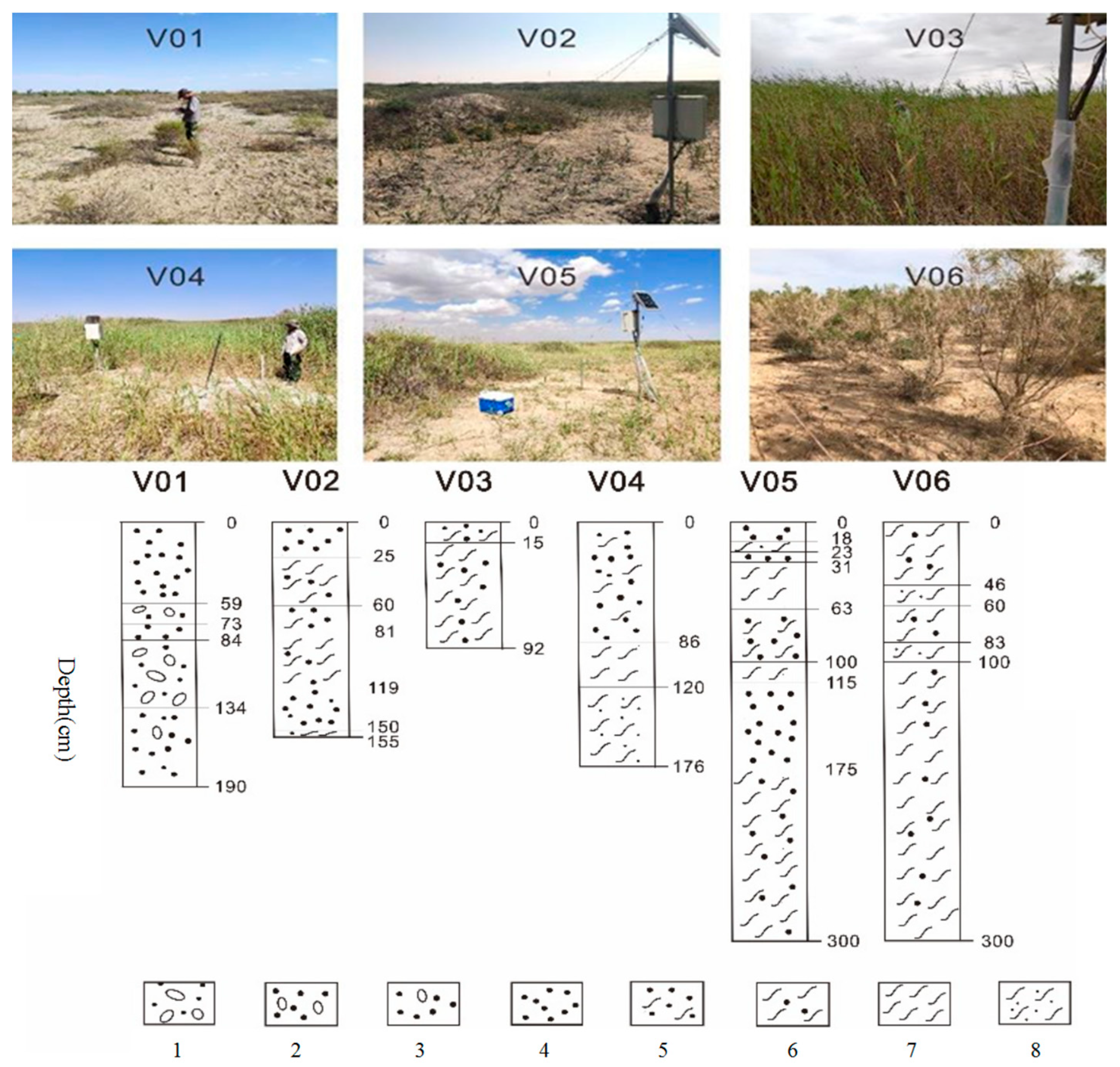
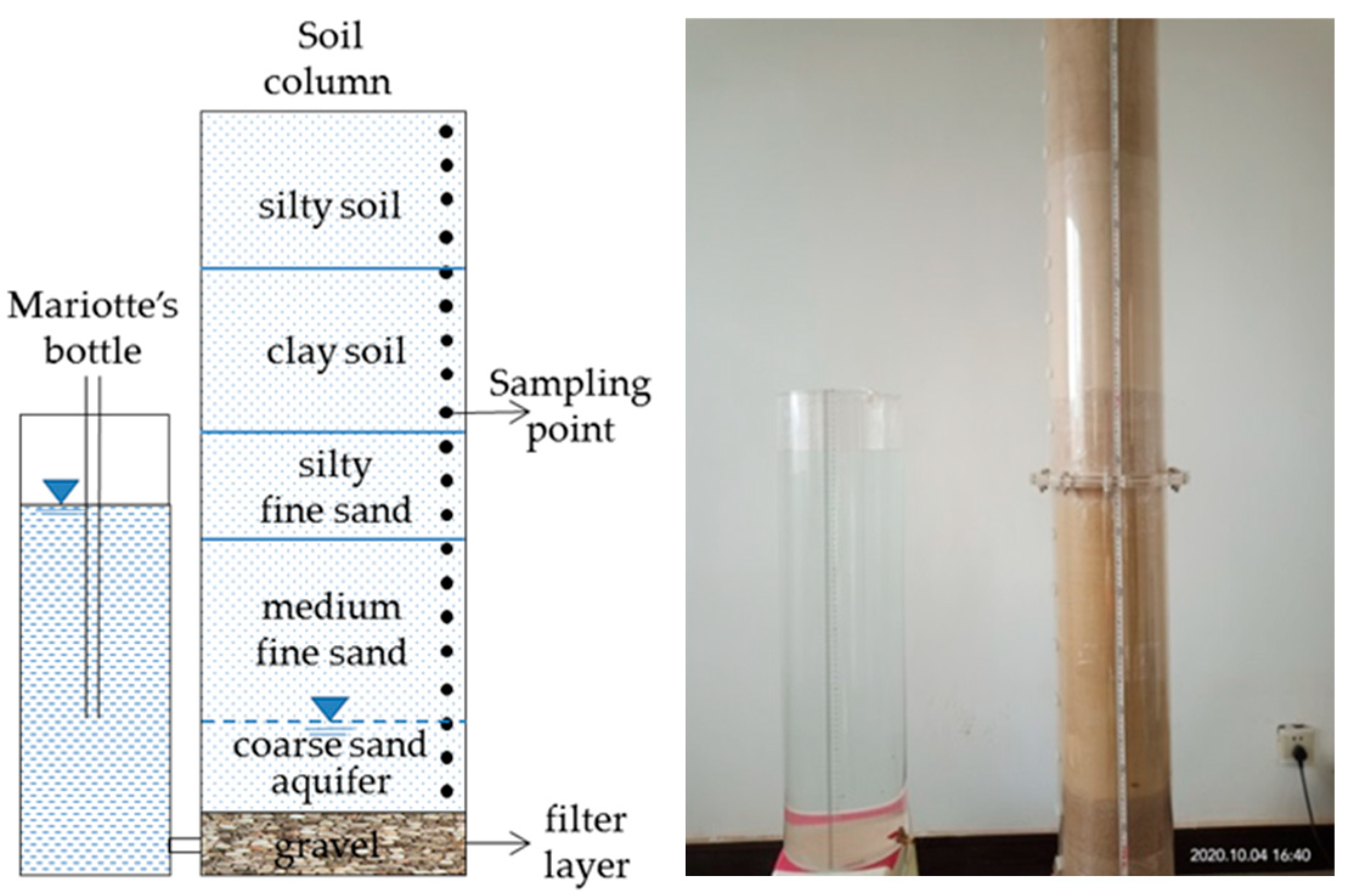



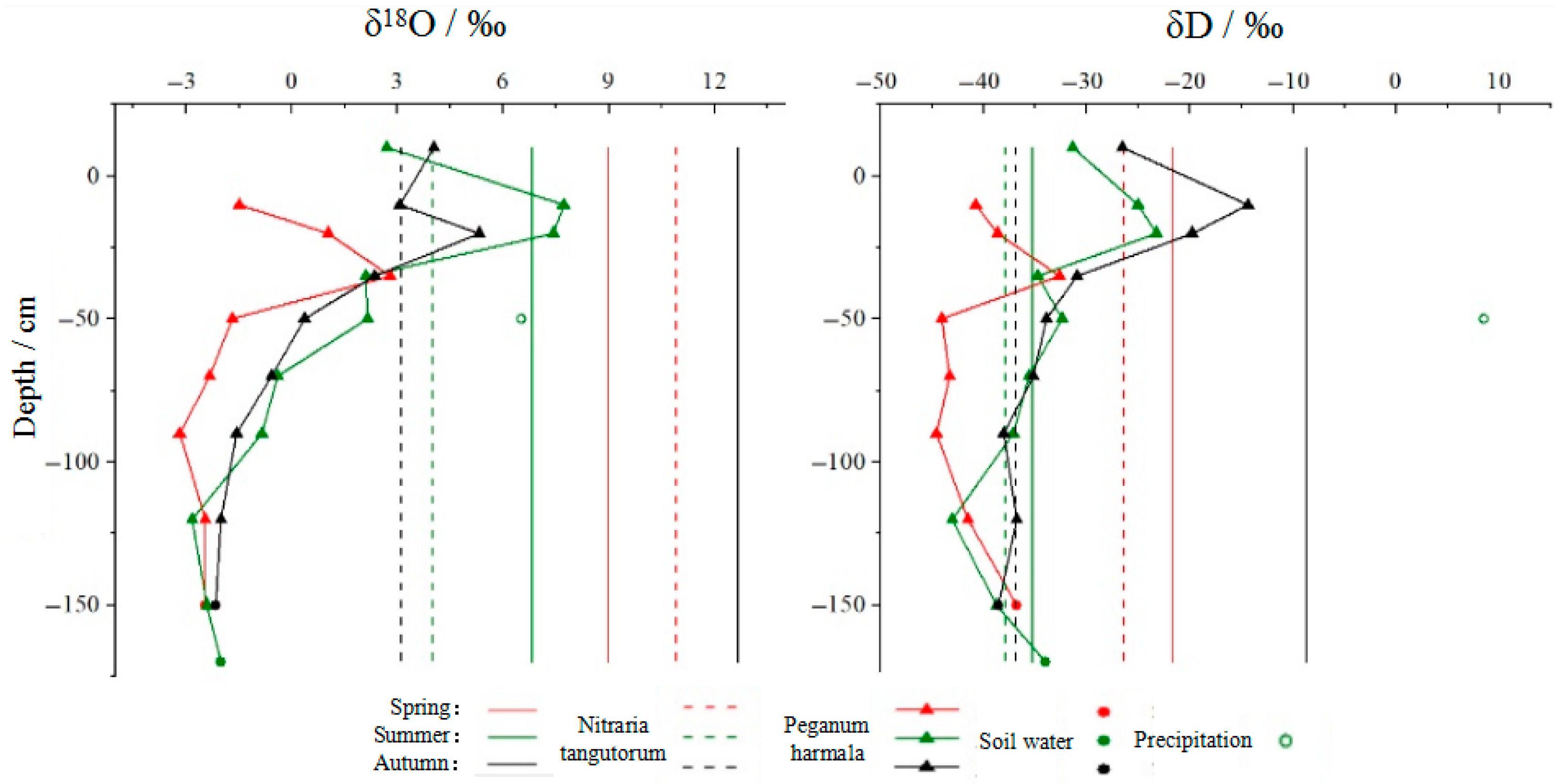

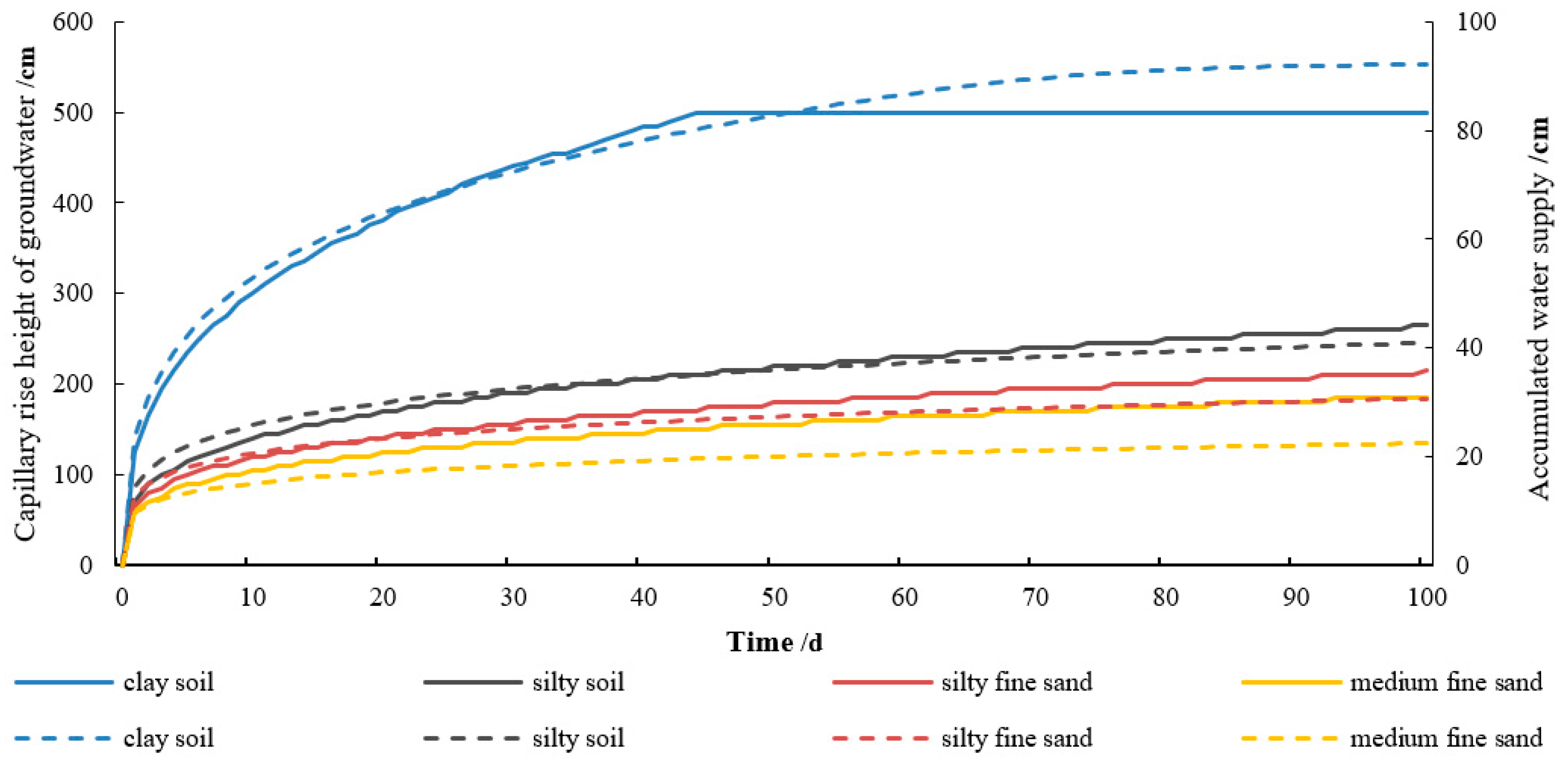
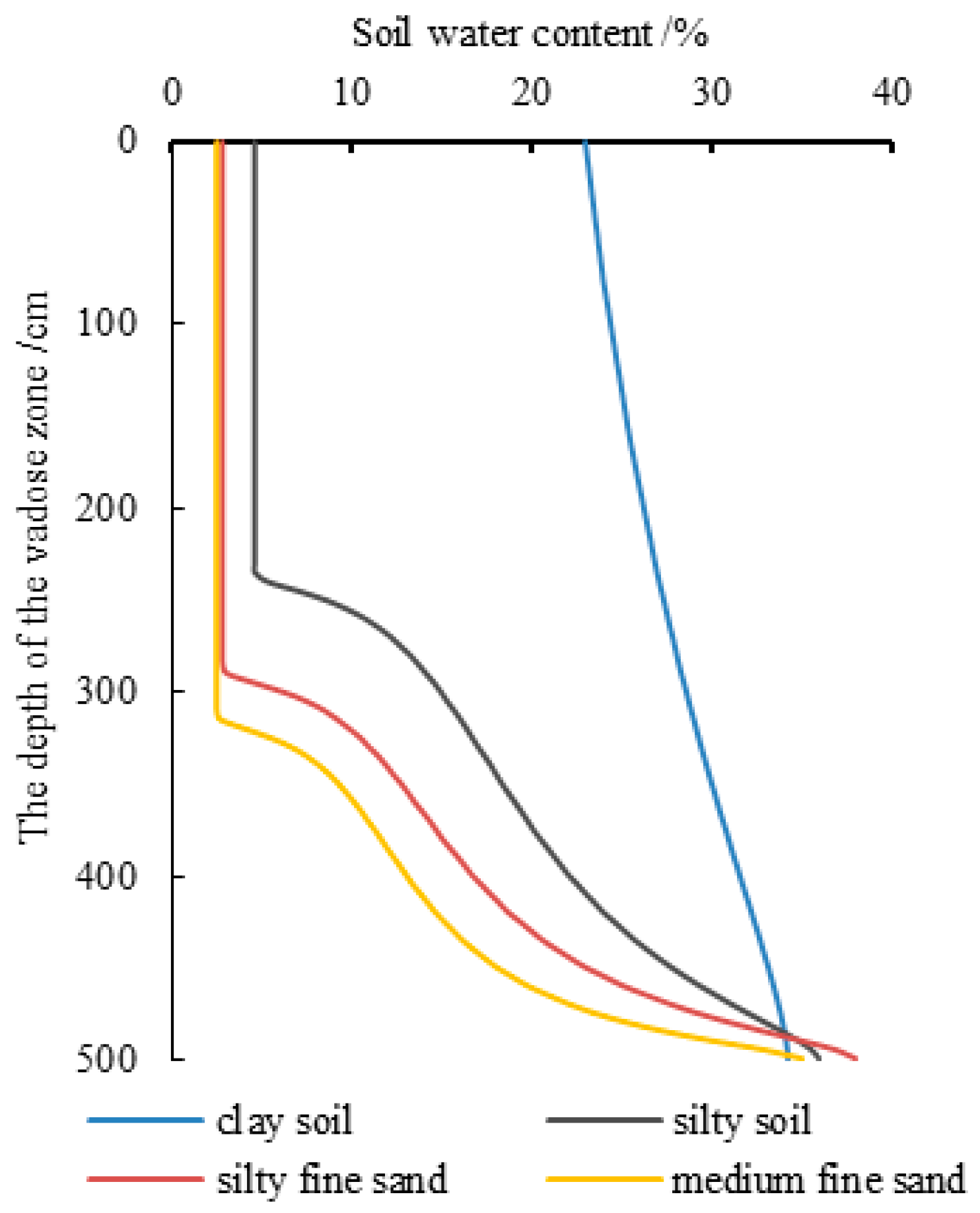
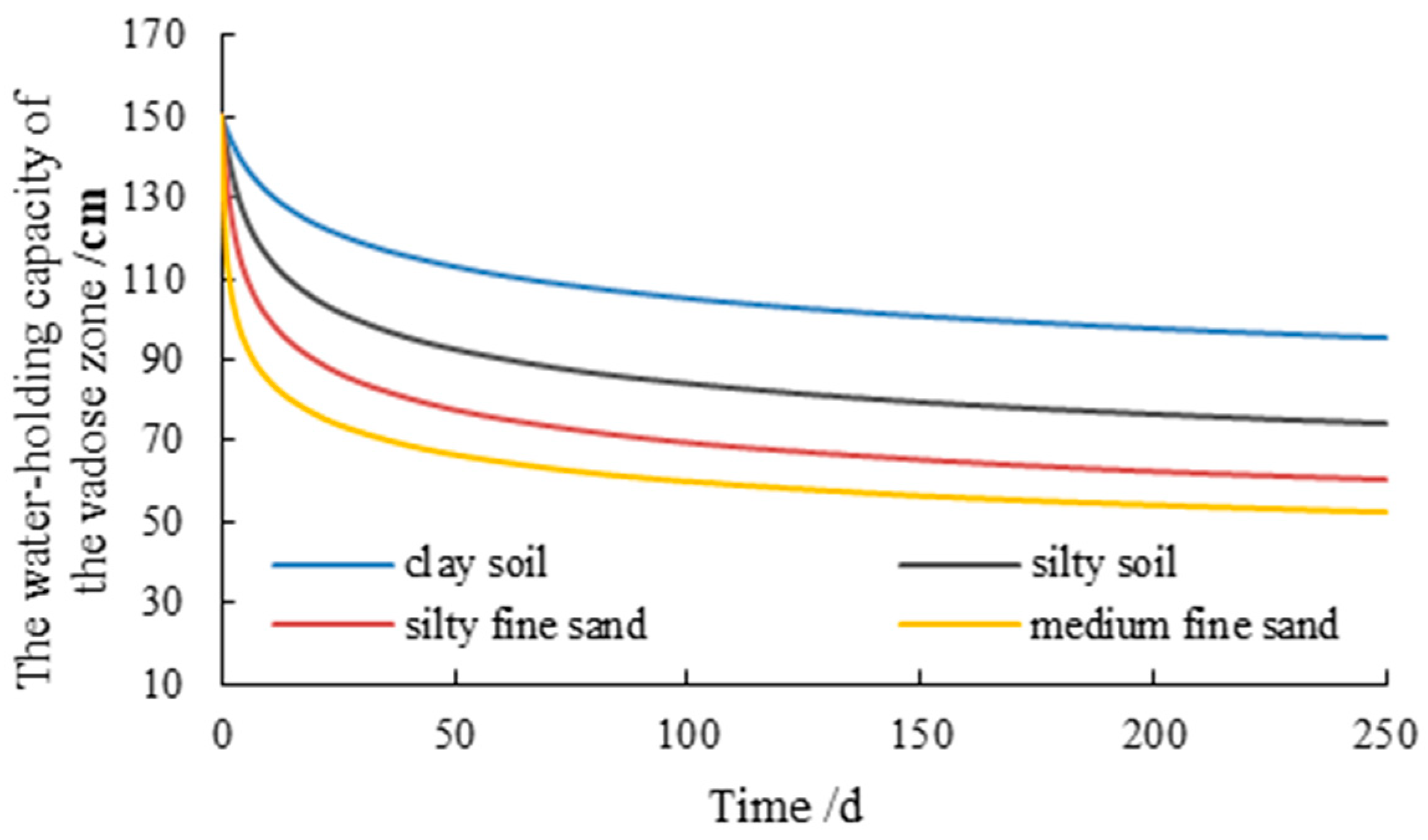

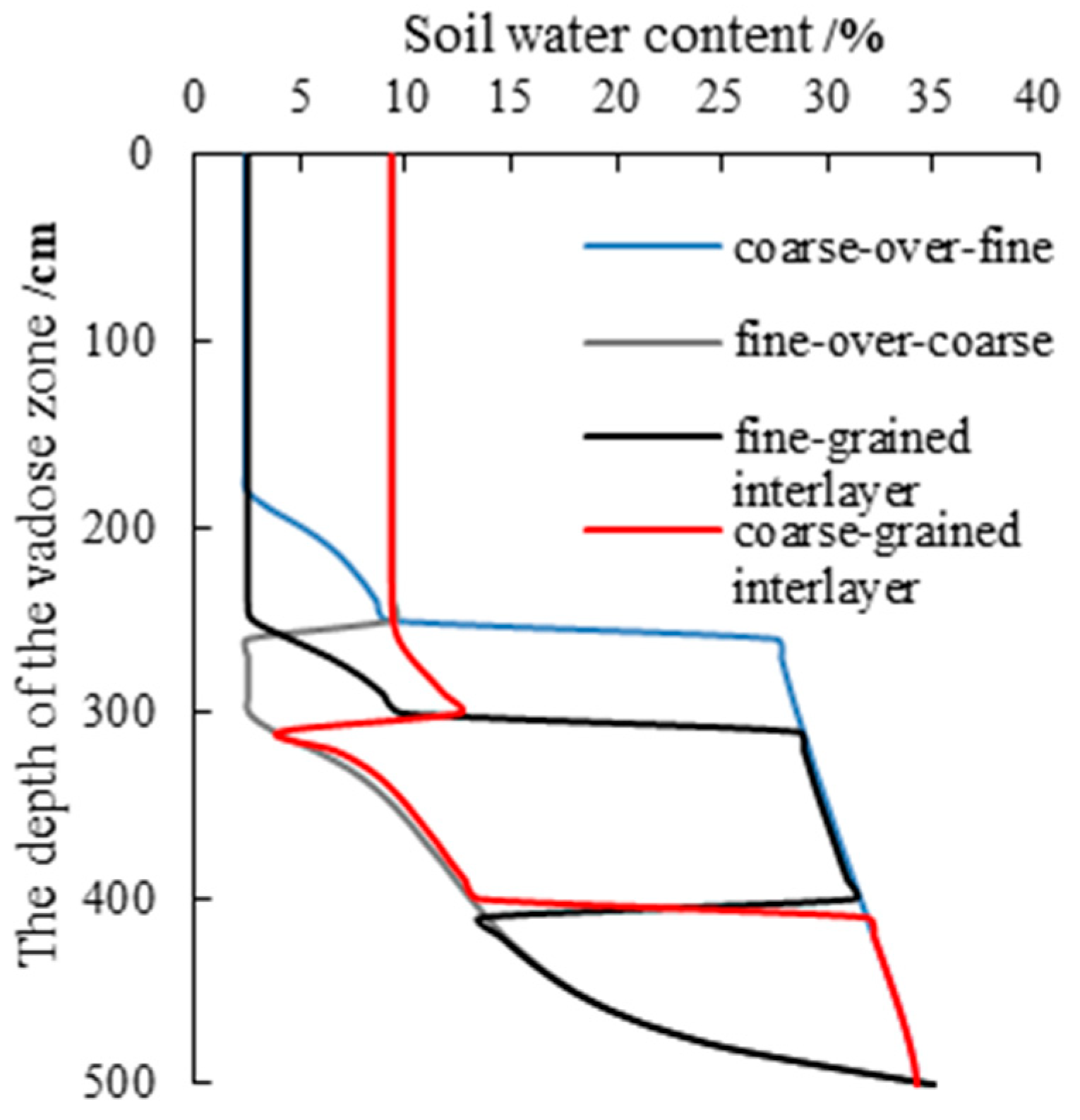


| Lithology | Percentage of Different Soil Particles/% | Dry Bulk Density g/cm3 | |||||
|---|---|---|---|---|---|---|---|
| >1 mm | 1–0.5 mm | 0.5–0.25 mm | 0.25–0.1 mm | 0.1–0.075 mm | <0.075 mm | ||
| silty soil | 0 | 0 | 0.04 | 47.78 | 20.82 | 31.36 | 1.35 |
| clay soil | 0.23 | 4.65 | 3.14 | 29.17 | 28.98 | 33.84 | 1.44 |
| silty fine sand | 0 | 0.24 | 17.88 | 53.90 | 15.32 | 12.66 | 1.51 |
| medium fine sand | 0.01 | 16.85 | 26.93 | 33.40 | 14.85 | 7.96 | 1.60 |
| Lithology | Residual Water Content/% | Saturated Water Content/% | Reciprocal of Air-Entry Value | Shape Factor | Saturated Hydraulic Conductivity/(cm·d−1) | Wilting Point Moisture Content/% |
|---|---|---|---|---|---|---|
| silty soil | 3.07 | 35.99 | 0.024 | 1.52 | 117.33 | 4.62 |
| clay soil | 5.35 | 34.27 | 0.005 | 1.46 | 47.85 | 9.32 |
| silty fine sand | 1.79 | 37.91 | 0.045 | 1.55 | 305.67 | 2.79 |
| medium fine sand | 1.44 | 35.00 | 0.075 | 1.5 | 642.98 | 2.44 |
| Lithology of the Vadose Zone | Clay Soil | Silty Soil | Silty Fine Sand | Medium Fine Sand |
|---|---|---|---|---|
| Residual water content/mm | 466.0 | 231.0 | 139.5 | 122.0 |
| Total water holding capacity/mm | 1130.0 | 927.8 | 778.7 | 666.7 |
| Available water capacity/mm | 664.0 | 696.8 | 639.2 | 544.7 |
| Ratio of available water capacity to total water holding capacity/% | 58.76 | 75.10 | 82.09 | 81.70 |
| Lithology of the Vadose Zone | Coarse-Over-Fine | Fine-Over-Coarse | Fine-Grained Interlayer | Coarse-Grained Interlayer |
|---|---|---|---|---|
| Residual water content/mm | 294.0 | 294.0 | 190.8 | 397.2 |
| Total water holding capacity/mm | 861.4 | 1029.7 | 812.4 | 1146.8 |
| Available water capacity/mm | 567.4 | 735.7 | 621.6 | 749.6 |
| Ratio of available water capacity to total water holding capacity/% | 65.87 | 71.45 | 76.51 | 65.36 |
Disclaimer/Publisher’s Note: The statements, opinions and data contained in all publications are solely those of the individual author(s) and contributor(s) and not of MDPI and/or the editor(s). MDPI and/or the editor(s) disclaim responsibility for any injury to people or property resulting from any ideas, methods, instructions or products referred to in the content. |
© 2025 by the authors. Licensee MDPI, Basel, Switzerland. This article is an open access article distributed under the terms and conditions of the Creative Commons Attribution (CC BY) license (https://creativecommons.org/licenses/by/4.0/).
Share and Cite
Cui, H.; Shang, J.; Lang, X.; Zhang, G.; Wang, Q.; Yan, M. Characteristics and Mechanisms of the Impact of Heterogeneity in the Vadose Zone of Arid Regions on Natural Vegetation Ecology: A Case Study of the Shiyang River Basin. Sustainability 2025, 17, 6605. https://doi.org/10.3390/su17146605
Cui H, Shang J, Lang X, Zhang G, Wang Q, Yan M. Characteristics and Mechanisms of the Impact of Heterogeneity in the Vadose Zone of Arid Regions on Natural Vegetation Ecology: A Case Study of the Shiyang River Basin. Sustainability. 2025; 17(14):6605. https://doi.org/10.3390/su17146605
Chicago/Turabian StyleCui, Haohao, Jinyu Shang, Xujuan Lang, Guanghui Zhang, Qian Wang, and Mingjiang Yan. 2025. "Characteristics and Mechanisms of the Impact of Heterogeneity in the Vadose Zone of Arid Regions on Natural Vegetation Ecology: A Case Study of the Shiyang River Basin" Sustainability 17, no. 14: 6605. https://doi.org/10.3390/su17146605
APA StyleCui, H., Shang, J., Lang, X., Zhang, G., Wang, Q., & Yan, M. (2025). Characteristics and Mechanisms of the Impact of Heterogeneity in the Vadose Zone of Arid Regions on Natural Vegetation Ecology: A Case Study of the Shiyang River Basin. Sustainability, 17(14), 6605. https://doi.org/10.3390/su17146605





